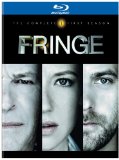| Reviews & Columns |
|
Reviews DVD TV on DVD Blu-ray 4K UHD International DVDs In Theaters Reviews by Studio Video Games Features Collector Series DVDs Easter Egg Database Interviews DVD Talk Radio Feature Articles Columns Anime Talk DVD Savant Horror DVDs The M.O.D. Squad Art House HD Talk Silent DVD
|
DVD Talk Forum |
|
|
| Resources |
|
DVD Price Search Customer Service #'s RCE Info Links |
|
Columns
|
|
|
Fringe: The Complete First Season
Warner Bros. // Unrated // September 8, 2009
List Price: $79.98 [Buy now and save at Amazon]
The Season:
LOST creator J.J. Abrams has built an entire little empire around maintaining tight-lipped secrecy with psychobabble-laced answers to the questions his show raises, all of which lie underneath a thick, secretive shell ready for the cracking. He's got all these complex ideas firing off in his brain about the island, yet he adheres to the ambiguousness that makes his post-"Alias" flagship program a blast upon both initial viewing and with the rant-worthy theorizing that occurs afterwards. It'd be near-impossible for most writers to dance around and contain their internal ponderings, which is where Abrams' and co-creators Roberto Orci and Alex Kurtzman's new creation Fringe comes into play. While he's busy fogging up his other series, Fringe serves as an outlet for all the crazed theoretical concepts that his crew has rolling around in their noggins -- and they've got some whoppers.
It begins with an explosion, like many sci-fi story arcs do. While researching a lead on a biochemical case, FBI agents Olivia Dunham (Anna Torv) and John Scott (Mark Valley) are shot backwards by a massive blast outside of a public storage unit -- rendering agent Scott near death and contracted with an odd virus. Somehow, this explosion correlates with a massive airline conspiracy that's believed to be a violent act of bio-terrorism that claimed the lives of everyone aboard a particular flight. After some digging, Agent Dunham keeps stumbling across one name that might know something about the incident: Walter Bishop (John Noble), a brilliant experimental scientist under lock-and-key in a mental institution. Only to get to him, she's got to convince his estranged twenty-something year old son Peter (Joshua Jackson) -- a cynical yet brilliant 190+ IQ rebel with serious authority issues -- to come with her.
The content in the two-hour premiere of Fringe could fill an entire season's worth of material; however, in J.J. Abrams' world, it's only the framework. Olivia, Peter, and Walter end up working together in a purposely overlooked extension of the FBI entitled the Fringe Division, a branch that focuses on cases that come close to the barrier between scientific explanations and, well, the unknown -- mostly interacting with a connected array of events entitled "The Pattern". Walter turns into an exploratory guide for the ragtag cluster of agents, dissecting cadaver after cadaver in his lab and revealing bits and pieces regarding the connection between his findings and the controversial research he conducted many years ago. These happenings, after some crackerjack sleuthing from Agent Dunham, have more than a small amount of connective tissue to a large pharmaceutical research corporation, Massive Dynamic.
In the first seven or eight episodes, Fringe tests the waters with its scientific conceptualizations as Agent Dunham races against the clock to crack these beyond-the-norm cases. With Peter questioning every move his father makes -- both as a jaded intellectual and as an abandoned son -- and Olivia's relative virginity to the concept of Fringe science, we're dragged through the tough sell in convincing them that these things exist. It's hard for the audience to digest as well, mainly because some of these ideas actually have some resemblance to scientific sensibility. Though the application of these ideas are something beyond our grasp as "rational" humans, such as communicating with the dead by connecting consciousness, "memories" being harvested by means of images burned onto eyeballs, and the reconstitution of matter as thick as steel into something malleable via sound, each bizarre concept is verbalized in a way that makes each theory make as much sense as it can within the 45-minute episodic timeframe.
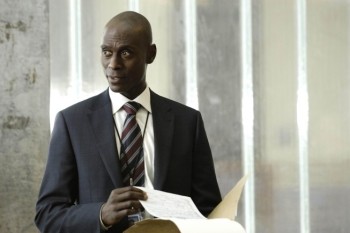 Since these ideas are rather complex, Fringe goes through plenty of tonal growing pains with the first third of its premiere season. Though the ideas are interesting, Abrams and his writing crew have a difficult time striking a balance between the theories, character intrigue, and ultimately crafting a piece of thrilling television. At the start, they usually hit two of those bullet points out of the three, all while slowly developing the character dynamics. But, at the start, each episode is missing something -- whether it's a strong character or a grasp on reality. They still has plenty to offer, especially with a superbly constructed demeanor that reflects a blend of LOST with X-Files style of peculiarity and a grasp on grotesqueness that mirrors the work of David Cronenberg. Excellent props work and clever writing keep it within reach of realism, even when things like giant parasitic slugs and other more "monstrous" elements stumble into Walter's laboratory ripe for dissection.
Since these ideas are rather complex, Fringe goes through plenty of tonal growing pains with the first third of its premiere season. Though the ideas are interesting, Abrams and his writing crew have a difficult time striking a balance between the theories, character intrigue, and ultimately crafting a piece of thrilling television. At the start, they usually hit two of those bullet points out of the three, all while slowly developing the character dynamics. But, at the start, each episode is missing something -- whether it's a strong character or a grasp on reality. They still has plenty to offer, especially with a superbly constructed demeanor that reflects a blend of LOST with X-Files style of peculiarity and a grasp on grotesqueness that mirrors the work of David Cronenberg. Excellent props work and clever writing keep it within reach of realism, even when things like giant parasitic slugs and other more "monstrous" elements stumble into Walter's laboratory ripe for dissection.
Fringe finally zeroes in on the element missing from the first episodes, something that drags down the forefront of the season: a sense of immediacy driving behind a central plot device. While watching Peter and Olivia grapple tech and science was a necessary blunder, it's only once we've crossed those hurdles and begin to focus on a central threat that the real fun begins. As we learn more about Massive Dynamic, its leader William Bell, and Olivia's past in Jacksonville, the series roots itself in a conspiracy-filled universe by connecting nearly every mystery that Fringe Division solves to the multi-billion dollar science research firm. And, boy, does it transform into edge-of-your-seat, sublimely addictive television at that point.
Anna Torv steps into the spotlight from the start as Agent Olivia Dunham, staying interesting to just the right degrees without taking away from the momentum built by the sci-fi based mystery. She projects strength through her disposition and commanding voice, possibly recognizable by video game aficionados as Nariko from Heavenly Sword. Her power never comes across as false or forced, exerting herself to just the right degrees over her fellow FBI agents, namely her superior Agent Broyles, played with a little more verbal oomph by LOST veteran Lance Reddick, and Agent Charlie Francis (Kirk Acevedo).
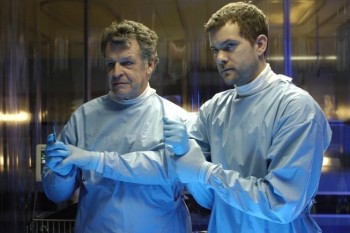 Joshua Jackson and John Noble create an amiable dynamic as Peter and Dr. Walter Bishop, something that the cold yet compelling series needs during its tauter moments. Jackson, no matter how hard he tries, will always have a difficult time dodging the label as a "Dawson's Creek" child; however, he's certainly charming and talented enough to give Peter a charismatic gruffness. Jackson's put in a position where he has to pull together the few successful elements he nailed from his performances in The Skulls and Gossip, then pump them full of brainiac intelligence and a rebellious flair. He gets right more times than not, yet he also falls into that growth period where he has to find his own as Peter -- which he eventually nails down at about the same point when Fringe kicks into full-throttle. John Noble, however, is absolutely electric as the scatterbrained Walter from the get-go, mumbling scientific revelations in between his fixations on food that he missed while in the mental institution. Their banter, often one-sided with peculiarity from Noble, adds "lighter" moments to the show.
Joshua Jackson and John Noble create an amiable dynamic as Peter and Dr. Walter Bishop, something that the cold yet compelling series needs during its tauter moments. Jackson, no matter how hard he tries, will always have a difficult time dodging the label as a "Dawson's Creek" child; however, he's certainly charming and talented enough to give Peter a charismatic gruffness. Jackson's put in a position where he has to pull together the few successful elements he nailed from his performances in The Skulls and Gossip, then pump them full of brainiac intelligence and a rebellious flair. He gets right more times than not, yet he also falls into that growth period where he has to find his own as Peter -- which he eventually nails down at about the same point when Fringe kicks into full-throttle. John Noble, however, is absolutely electric as the scatterbrained Walter from the get-go, mumbling scientific revelations in between his fixations on food that he missed while in the mental institution. Their banter, often one-sided with peculiarity from Noble, adds "lighter" moments to the show.
Then, with little surprise to fans, Fringe crescendos in grand fashion as more of the mystery floats to the surface towards the season's mind-numbing close -- which swells to satisfyingly excessive levels much like Abrams' other work. A talented roster of directors has been enlisted, including The Machinist director Brad Anderson for five episodes and I Am Legend producer/screenplay writer Akiva Goldsman for a couple, to breathe cinematic life into each episode. Though episodic with every threat that comes barreling into Fringe Division's life, each installment carries freshness about the dialogue that continues to generate gut-curdling electricity.
Abrams and crew know how to blend humor, tension, and dramatic integrity into a thoroughly unique story, and the deeply rooted science-fiction base in Fringe proves that their creative usage of sources -- ranging from contemporary and classic films of the genre to their own use of composers, writers, and producers from Abrams' previous creations -- can yet again transform into something unique and stimulating. In a state of television where promising sci-fi series like Heroes have buckled under the pressure (jumped the shark, nuked the fridge, other metaphors for "begin to stink"), here's hoping that they can keep the energy as appointment-worthy and mindfully written. We might just have another LOST on our hands, if it keeps up the chaotic, mentally explosive energy from the finale.
The Blu-ray:
Available on five discs, Warner Bros' high-definition presentation of Fringe: The Complete First Season comes in a slim multi-disc presentation similar to the re-packaged Blade Runner Blu-rays. Inside, a slick little Episode Guide has been included with short, semi-spoiler laden descriptions attached to each. On top, a lenticular slipcover has been included -- much to this reviewer's discomfort (that sound of fingernails against the ridges always gets a shiver).
Each disc starts the episodes immediately, with only the first disc showcasing the now-commonplace Warner Blu-ray promotional commercial with that wacky shot of Troy before and after the high-def polish. Aside from that, you're dropped right into the action following the WB logo, with four to five episodes per disc that interconnect one right after the other. Accessing the special features can be done within the episode by pushing the Pop-Up Menu button.
Video and Audio:
Visually, each 1.78:1 framed episode looks extremely good in Warner's 1080p VC-1 treatments. Fringe mostly sports a cold, blue-leaning color timing in its cinematography, which offers up a prime opportunity to explore differences in contrast. Inky blacks are the result, on top of making the splashes of color in the photography -- flesh tones, rays of light, odd-colored water, etc -- to shine. The presentation has an extremely natural feel, which reveals both a positive and a negative. Plenty of noise dances around in the backdrop of many scenes, which is enough to, at times, draw attention away from the focal points in the program and make it feel a little flat. Yet, on the other side of things, detail is rendered with rather fine crispness, with only the scantest visible edge enhancement popping up in only one or two scenes throughout the entire series.
There's a bullet to take with the audio treatment, as Warner has opted to only go with a Dolby Digital 5.1 track instead of TrueHD for this release. It's noticeable whenever a gunshot pops up or during a few sequences where clarity of dialogue gets a little muffled and rewind-worthy. However, it's certainly a potent legacy track aside from that, making the bombardment of musical cues highly audible and the other sound effects -- like Walter's dissecting in the lab or the blasts of a villain's ray gun -- very pleasant to the ear. It almost reflects on the source more than the audio treatment, since the blasts of a real firearm receive some repression in the track while the potent mid-range firing of that gun fills the soundstage with plenty high-end and middle-set bass. Most of the time, though, dialogue stays clean to the ear while ambient sound effects keep the energy plenty alive. Though copyright warnings pop up in many, many languages at the end of each disc, the only Audio/Subtitle options are in English.
Special Features:
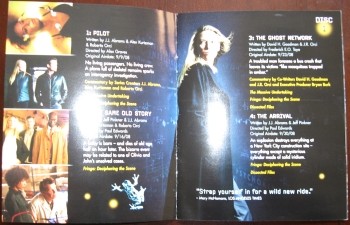 Commentaries:
Commentaries:
Audio commentary tracks are available with the Pilot, "The Ghost Network", and "Bad Dreams", each one featuring different crew members from the series. Creators Abrams, Alex Kurtzman, and Roberto Orci guide us through the pilot without a pre-planned agenda, keeping the content on a per scene basis. They cover elements such as their usage of a plane at the start of the episode, the flip-flopping of direction between being an X-Files emulation with Agent Scott and Agent Dunham to an Olivia-driven plotline, and the focus on Walter as a "mad scientist". They name drop "Altered States" and David Cronenberg during their talks, along with taking it into a personal journey as Abrams feeling it would be "fun" to do it with these particular producers.
J.R. Orci, David Goodman and Byron Burk take a stab at commentating on "The Ghost Network", a very strange episode that merits some feedback. These guys have fun with the track, along with tossing out nuggets of information regarding whether items were scripted or not, merit behind the performances, etc. "Bad Dreams" features commentary from Akiva Goldsman and Jeff Pinknar, discussing shooting in New York, the difference between filming feature films and television episodes (revolving around scale and steadicam usage), and about a few details that might have slipped vision first time through (such as a box that might have gone unnoticed).
Massive Undertaking (VC-1 SD):
Also included with the three episodes with commentary tracks are short featurettes that cover the grandness of scale for each one (hence the title, "Massive Undertaking"). Some are longer than others, but most of them blend interview time and concept discussion -- along with some insight into what's to come with the next season:
Deciphering the Scene (VC-1 SD):
Each episode is paired with a short making-of snippet that usually about a minute and a half to two minutes in length, which cover one of the central production elements in the focus episode. From prosthetic eyeballs to explosives on buses, we get a quick inside look at the troubles that the crew engage in week-by-week.
Along with those features, many episodes also come with Dissected Files (VC-1 SD), which essentially translated to "deleted scenes". Some last a minute or two, while others only linger between 30-45 seconds.
-----
On Disc Four, the spoiler-rich special features are brought into the mix. Noted by a large WARNING paragraph that makes certain you've seen the episodes before viewing, these pieces could certainly ruin the surprises that lie ahead on the fifth disc.
The Genesis of Fringe (9:07, VC-1 SD):
This is an origin piece that covers Kurtzman, Abrams, and Orci discussing their conversations about the work. It mentions their influences -- "Twilight Zone", "Altered States", and David Cronenberg's work -- and how the series developed as a core story instead of an on-running developing idea to pitch to the studios.
The Real Science Behind Fringe (10:26, VC-1 SD):
This feature attempts to clarify the interesting scientific concepts behind the episodes. It covers rapid growth in children, retina image burning, torpedoes through the earth and more, featuring science consultants who give a little historical breadth to each idea.
Casting of Fringe (9:21, VC-1 SD):
Finally, this piece explores how the creators came up with the actors present in the pilot, discussing how it seems as if each actor walked into the room and "owned" their character -- and how they make them feel human. It covers how Torv interviewed over webcam, includes audition footage from most actors involved, and finds focus on how John Noble found his character of Walter and overcome the notion of him not being quite right -- too humorous, too young.
-----
On Disc Five, we've got an array of extra features that include Roberto Orci's Production Diary (13:06, SD VC-1), which focuses on the assembly behind the premiere episode, Fringe Visual Effects (15:16, SD VC-1) covering the digital imagery the series uses on a limited budget, as well as Unusual Side Effects (4:32, SD VC-1) gag reel and a featurette on the cow entitled Gene the Cow (2:46) -- actually named Pansy, among other names.
Fringe Pattern Analysis (VC-1):
Utilizing six episodes from the series, experts dissect the science behind the radical elements at play in the central element, "The Pattern". It utilizes a creatively-designed interface that plays interview footage with experts next to alternate footage, usually clips from the show. The six installments feature "The Ghost Network" (3:53), "Power Hungry" (4:55), "The Equation" (3:14), "Safe" (3:26), "The Transformation" (3:55), and "Unleashed" (5:55). Sketches from Walter's journal come into play, as well as a rundown of the credentials behind each of the interviewed doctors featured.
Disc Five has also been BD-Live enabled with Warner Bros' service, following a lengthy registration through a relatively simple interface.
Final Thoughts:
As a complete package, the freshman season of Fringe resembles a film with a overlong first act that leads into a thrilling, tightly-executed second and third portions. Muscling past that group of strong yet lacking episodes leads to roughly two-thirds of a mesmerizing, addictive season -- and a new appointment-worthy series. Though J.J. Abrams' creation is a little shaky at the start and only sporting a Dolby Digital 5.1 track, this is a very Highly Recommended package on Blu-ray (at least, for English-speaking viewers) with extremely strong visuals and a nice array of commentaries, featurettes, and added little tidbits to satisfy after the series has concluded.
Thomas Spurlin, Staff Reviewer -- DVDTalk Reviews | Personal Blog/Site
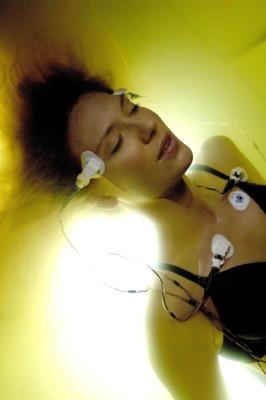 |
It begins with an explosion, like many sci-fi story arcs do. While researching a lead on a biochemical case, FBI agents Olivia Dunham (Anna Torv) and John Scott (Mark Valley) are shot backwards by a massive blast outside of a public storage unit -- rendering agent Scott near death and contracted with an odd virus. Somehow, this explosion correlates with a massive airline conspiracy that's believed to be a violent act of bio-terrorism that claimed the lives of everyone aboard a particular flight. After some digging, Agent Dunham keeps stumbling across one name that might know something about the incident: Walter Bishop (John Noble), a brilliant experimental scientist under lock-and-key in a mental institution. Only to get to him, she's got to convince his estranged twenty-something year old son Peter (Joshua Jackson) -- a cynical yet brilliant 190+ IQ rebel with serious authority issues -- to come with her.
The content in the two-hour premiere of Fringe could fill an entire season's worth of material; however, in J.J. Abrams' world, it's only the framework. Olivia, Peter, and Walter end up working together in a purposely overlooked extension of the FBI entitled the Fringe Division, a branch that focuses on cases that come close to the barrier between scientific explanations and, well, the unknown -- mostly interacting with a connected array of events entitled "The Pattern". Walter turns into an exploratory guide for the ragtag cluster of agents, dissecting cadaver after cadaver in his lab and revealing bits and pieces regarding the connection between his findings and the controversial research he conducted many years ago. These happenings, after some crackerjack sleuthing from Agent Dunham, have more than a small amount of connective tissue to a large pharmaceutical research corporation, Massive Dynamic.
In the first seven or eight episodes, Fringe tests the waters with its scientific conceptualizations as Agent Dunham races against the clock to crack these beyond-the-norm cases. With Peter questioning every move his father makes -- both as a jaded intellectual and as an abandoned son -- and Olivia's relative virginity to the concept of Fringe science, we're dragged through the tough sell in convincing them that these things exist. It's hard for the audience to digest as well, mainly because some of these ideas actually have some resemblance to scientific sensibility. Though the application of these ideas are something beyond our grasp as "rational" humans, such as communicating with the dead by connecting consciousness, "memories" being harvested by means of images burned onto eyeballs, and the reconstitution of matter as thick as steel into something malleable via sound, each bizarre concept is verbalized in a way that makes each theory make as much sense as it can within the 45-minute episodic timeframe.
 Since these ideas are rather complex, Fringe goes through plenty of tonal growing pains with the first third of its premiere season. Though the ideas are interesting, Abrams and his writing crew have a difficult time striking a balance between the theories, character intrigue, and ultimately crafting a piece of thrilling television. At the start, they usually hit two of those bullet points out of the three, all while slowly developing the character dynamics. But, at the start, each episode is missing something -- whether it's a strong character or a grasp on reality. They still has plenty to offer, especially with a superbly constructed demeanor that reflects a blend of LOST with X-Files style of peculiarity and a grasp on grotesqueness that mirrors the work of David Cronenberg. Excellent props work and clever writing keep it within reach of realism, even when things like giant parasitic slugs and other more "monstrous" elements stumble into Walter's laboratory ripe for dissection.
Since these ideas are rather complex, Fringe goes through plenty of tonal growing pains with the first third of its premiere season. Though the ideas are interesting, Abrams and his writing crew have a difficult time striking a balance between the theories, character intrigue, and ultimately crafting a piece of thrilling television. At the start, they usually hit two of those bullet points out of the three, all while slowly developing the character dynamics. But, at the start, each episode is missing something -- whether it's a strong character or a grasp on reality. They still has plenty to offer, especially with a superbly constructed demeanor that reflects a blend of LOST with X-Files style of peculiarity and a grasp on grotesqueness that mirrors the work of David Cronenberg. Excellent props work and clever writing keep it within reach of realism, even when things like giant parasitic slugs and other more "monstrous" elements stumble into Walter's laboratory ripe for dissection. Fringe finally zeroes in on the element missing from the first episodes, something that drags down the forefront of the season: a sense of immediacy driving behind a central plot device. While watching Peter and Olivia grapple tech and science was a necessary blunder, it's only once we've crossed those hurdles and begin to focus on a central threat that the real fun begins. As we learn more about Massive Dynamic, its leader William Bell, and Olivia's past in Jacksonville, the series roots itself in a conspiracy-filled universe by connecting nearly every mystery that Fringe Division solves to the multi-billion dollar science research firm. And, boy, does it transform into edge-of-your-seat, sublimely addictive television at that point.
Anna Torv steps into the spotlight from the start as Agent Olivia Dunham, staying interesting to just the right degrees without taking away from the momentum built by the sci-fi based mystery. She projects strength through her disposition and commanding voice, possibly recognizable by video game aficionados as Nariko from Heavenly Sword. Her power never comes across as false or forced, exerting herself to just the right degrees over her fellow FBI agents, namely her superior Agent Broyles, played with a little more verbal oomph by LOST veteran Lance Reddick, and Agent Charlie Francis (Kirk Acevedo).
 Joshua Jackson and John Noble create an amiable dynamic as Peter and Dr. Walter Bishop, something that the cold yet compelling series needs during its tauter moments. Jackson, no matter how hard he tries, will always have a difficult time dodging the label as a "Dawson's Creek" child; however, he's certainly charming and talented enough to give Peter a charismatic gruffness. Jackson's put in a position where he has to pull together the few successful elements he nailed from his performances in The Skulls and Gossip, then pump them full of brainiac intelligence and a rebellious flair. He gets right more times than not, yet he also falls into that growth period where he has to find his own as Peter -- which he eventually nails down at about the same point when Fringe kicks into full-throttle. John Noble, however, is absolutely electric as the scatterbrained Walter from the get-go, mumbling scientific revelations in between his fixations on food that he missed while in the mental institution. Their banter, often one-sided with peculiarity from Noble, adds "lighter" moments to the show.
Joshua Jackson and John Noble create an amiable dynamic as Peter and Dr. Walter Bishop, something that the cold yet compelling series needs during its tauter moments. Jackson, no matter how hard he tries, will always have a difficult time dodging the label as a "Dawson's Creek" child; however, he's certainly charming and talented enough to give Peter a charismatic gruffness. Jackson's put in a position where he has to pull together the few successful elements he nailed from his performances in The Skulls and Gossip, then pump them full of brainiac intelligence and a rebellious flair. He gets right more times than not, yet he also falls into that growth period where he has to find his own as Peter -- which he eventually nails down at about the same point when Fringe kicks into full-throttle. John Noble, however, is absolutely electric as the scatterbrained Walter from the get-go, mumbling scientific revelations in between his fixations on food that he missed while in the mental institution. Their banter, often one-sided with peculiarity from Noble, adds "lighter" moments to the show. Then, with little surprise to fans, Fringe crescendos in grand fashion as more of the mystery floats to the surface towards the season's mind-numbing close -- which swells to satisfyingly excessive levels much like Abrams' other work. A talented roster of directors has been enlisted, including The Machinist director Brad Anderson for five episodes and I Am Legend producer/screenplay writer Akiva Goldsman for a couple, to breathe cinematic life into each episode. Though episodic with every threat that comes barreling into Fringe Division's life, each installment carries freshness about the dialogue that continues to generate gut-curdling electricity.
Abrams and crew know how to blend humor, tension, and dramatic integrity into a thoroughly unique story, and the deeply rooted science-fiction base in Fringe proves that their creative usage of sources -- ranging from contemporary and classic films of the genre to their own use of composers, writers, and producers from Abrams' previous creations -- can yet again transform into something unique and stimulating. In a state of television where promising sci-fi series like Heroes have buckled under the pressure (jumped the shark, nuked the fridge, other metaphors for "begin to stink"), here's hoping that they can keep the energy as appointment-worthy and mindfully written. We might just have another LOST on our hands, if it keeps up the chaotic, mentally explosive energy from the finale.
The Blu-ray:
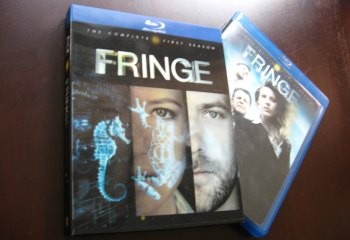 | 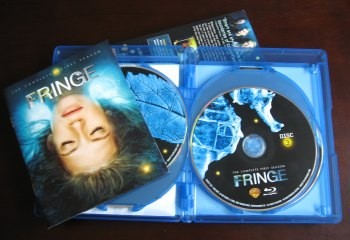 |
Available on five discs, Warner Bros' high-definition presentation of Fringe: The Complete First Season comes in a slim multi-disc presentation similar to the re-packaged Blade Runner Blu-rays. Inside, a slick little Episode Guide has been included with short, semi-spoiler laden descriptions attached to each. On top, a lenticular slipcover has been included -- much to this reviewer's discomfort (that sound of fingernails against the ridges always gets a shiver).
Each disc starts the episodes immediately, with only the first disc showcasing the now-commonplace Warner Blu-ray promotional commercial with that wacky shot of Troy before and after the high-def polish. Aside from that, you're dropped right into the action following the WB logo, with four to five episodes per disc that interconnect one right after the other. Accessing the special features can be done within the episode by pushing the Pop-Up Menu button.
Video and Audio:
Visually, each 1.78:1 framed episode looks extremely good in Warner's 1080p VC-1 treatments. Fringe mostly sports a cold, blue-leaning color timing in its cinematography, which offers up a prime opportunity to explore differences in contrast. Inky blacks are the result, on top of making the splashes of color in the photography -- flesh tones, rays of light, odd-colored water, etc -- to shine. The presentation has an extremely natural feel, which reveals both a positive and a negative. Plenty of noise dances around in the backdrop of many scenes, which is enough to, at times, draw attention away from the focal points in the program and make it feel a little flat. Yet, on the other side of things, detail is rendered with rather fine crispness, with only the scantest visible edge enhancement popping up in only one or two scenes throughout the entire series.
There's a bullet to take with the audio treatment, as Warner has opted to only go with a Dolby Digital 5.1 track instead of TrueHD for this release. It's noticeable whenever a gunshot pops up or during a few sequences where clarity of dialogue gets a little muffled and rewind-worthy. However, it's certainly a potent legacy track aside from that, making the bombardment of musical cues highly audible and the other sound effects -- like Walter's dissecting in the lab or the blasts of a villain's ray gun -- very pleasant to the ear. It almost reflects on the source more than the audio treatment, since the blasts of a real firearm receive some repression in the track while the potent mid-range firing of that gun fills the soundstage with plenty high-end and middle-set bass. Most of the time, though, dialogue stays clean to the ear while ambient sound effects keep the energy plenty alive. Though copyright warnings pop up in many, many languages at the end of each disc, the only Audio/Subtitle options are in English.
Special Features:
 Commentaries:
Commentaries: Audio commentary tracks are available with the Pilot, "The Ghost Network", and "Bad Dreams", each one featuring different crew members from the series. Creators Abrams, Alex Kurtzman, and Roberto Orci guide us through the pilot without a pre-planned agenda, keeping the content on a per scene basis. They cover elements such as their usage of a plane at the start of the episode, the flip-flopping of direction between being an X-Files emulation with Agent Scott and Agent Dunham to an Olivia-driven plotline, and the focus on Walter as a "mad scientist". They name drop "Altered States" and David Cronenberg during their talks, along with taking it into a personal journey as Abrams feeling it would be "fun" to do it with these particular producers.
J.R. Orci, David Goodman and Byron Burk take a stab at commentating on "The Ghost Network", a very strange episode that merits some feedback. These guys have fun with the track, along with tossing out nuggets of information regarding whether items were scripted or not, merit behind the performances, etc. "Bad Dreams" features commentary from Akiva Goldsman and Jeff Pinknar, discussing shooting in New York, the difference between filming feature films and television episodes (revolving around scale and steadicam usage), and about a few details that might have slipped vision first time through (such as a box that might have gone unnoticed).
Massive Undertaking (VC-1 SD):
Also included with the three episodes with commentary tracks are short featurettes that cover the grandness of scale for each one (hence the title, "Massive Undertaking"). Some are longer than others, but most of them blend interview time and concept discussion -- along with some insight into what's to come with the next season:
Deciphering the Scene (VC-1 SD):
Each episode is paired with a short making-of snippet that usually about a minute and a half to two minutes in length, which cover one of the central production elements in the focus episode. From prosthetic eyeballs to explosives on buses, we get a quick inside look at the troubles that the crew engage in week-by-week.
Along with those features, many episodes also come with Dissected Files (VC-1 SD), which essentially translated to "deleted scenes". Some last a minute or two, while others only linger between 30-45 seconds.
-----
On Disc Four, the spoiler-rich special features are brought into the mix. Noted by a large WARNING paragraph that makes certain you've seen the episodes before viewing, these pieces could certainly ruin the surprises that lie ahead on the fifth disc.
The Genesis of Fringe (9:07, VC-1 SD):
This is an origin piece that covers Kurtzman, Abrams, and Orci discussing their conversations about the work. It mentions their influences -- "Twilight Zone", "Altered States", and David Cronenberg's work -- and how the series developed as a core story instead of an on-running developing idea to pitch to the studios.
The Real Science Behind Fringe (10:26, VC-1 SD):
This feature attempts to clarify the interesting scientific concepts behind the episodes. It covers rapid growth in children, retina image burning, torpedoes through the earth and more, featuring science consultants who give a little historical breadth to each idea.
Casting of Fringe (9:21, VC-1 SD):
Finally, this piece explores how the creators came up with the actors present in the pilot, discussing how it seems as if each actor walked into the room and "owned" their character -- and how they make them feel human. It covers how Torv interviewed over webcam, includes audition footage from most actors involved, and finds focus on how John Noble found his character of Walter and overcome the notion of him not being quite right -- too humorous, too young.
-----
On Disc Five, we've got an array of extra features that include Roberto Orci's Production Diary (13:06, SD VC-1), which focuses on the assembly behind the premiere episode, Fringe Visual Effects (15:16, SD VC-1) covering the digital imagery the series uses on a limited budget, as well as Unusual Side Effects (4:32, SD VC-1) gag reel and a featurette on the cow entitled Gene the Cow (2:46) -- actually named Pansy, among other names.
Fringe Pattern Analysis (VC-1):
Utilizing six episodes from the series, experts dissect the science behind the radical elements at play in the central element, "The Pattern". It utilizes a creatively-designed interface that plays interview footage with experts next to alternate footage, usually clips from the show. The six installments feature "The Ghost Network" (3:53), "Power Hungry" (4:55), "The Equation" (3:14), "Safe" (3:26), "The Transformation" (3:55), and "Unleashed" (5:55). Sketches from Walter's journal come into play, as well as a rundown of the credentials behind each of the interviewed doctors featured.
Disc Five has also been BD-Live enabled with Warner Bros' service, following a lengthy registration through a relatively simple interface.
Final Thoughts:
As a complete package, the freshman season of Fringe resembles a film with a overlong first act that leads into a thrilling, tightly-executed second and third portions. Muscling past that group of strong yet lacking episodes leads to roughly two-thirds of a mesmerizing, addictive season -- and a new appointment-worthy series. Though J.J. Abrams' creation is a little shaky at the start and only sporting a Dolby Digital 5.1 track, this is a very Highly Recommended package on Blu-ray (at least, for English-speaking viewers) with extremely strong visuals and a nice array of commentaries, featurettes, and added little tidbits to satisfy after the series has concluded.
|
| Popular Reviews |
| Sponsored Links |
|
|
| Sponsored Links |
|
|
| Release List | Reviews | Shop | Newsletter | Forum | DVD Giveaways | Blu-Ray | Advertise |
|
Copyright 2024 DVDTalk.com All Rights Reserved. Legal Info, Privacy Policy, Terms of Use,
Manage Preferences,
Your Privacy Choices | |||||||









